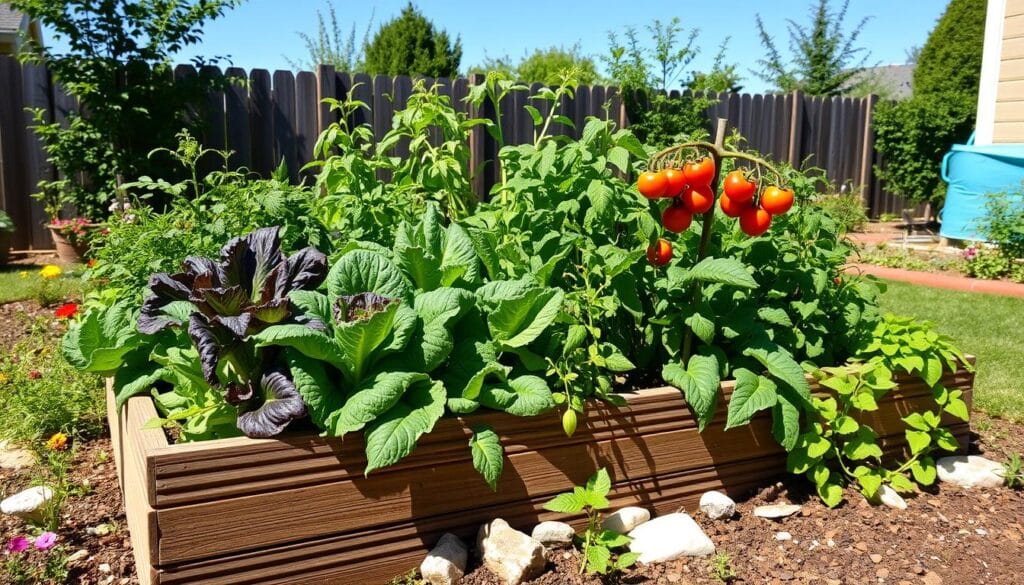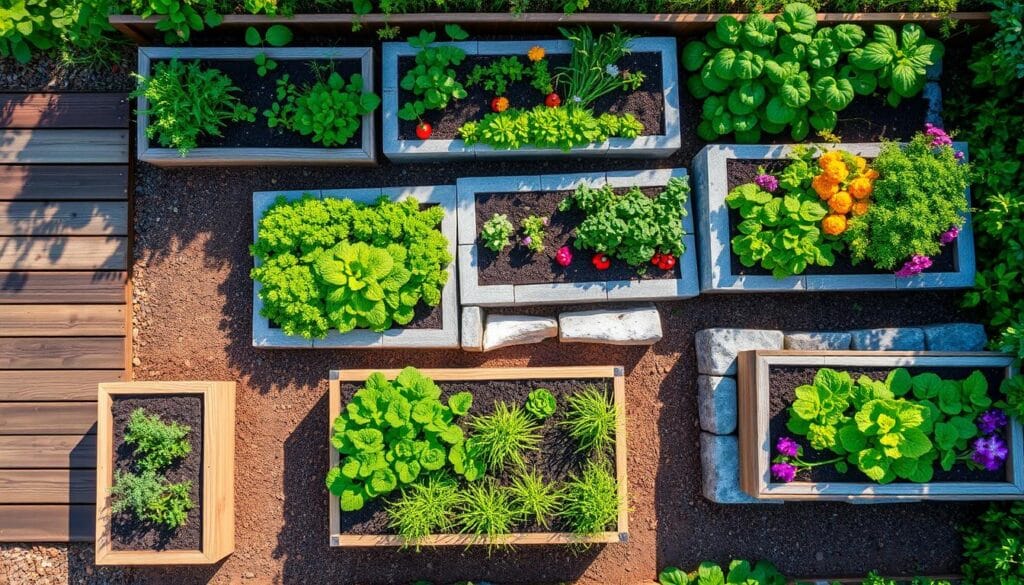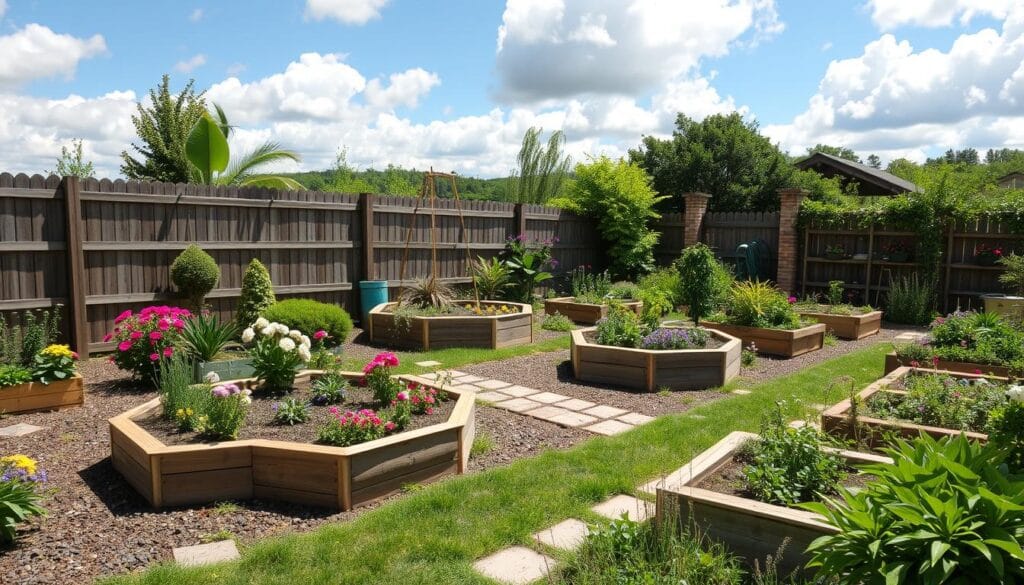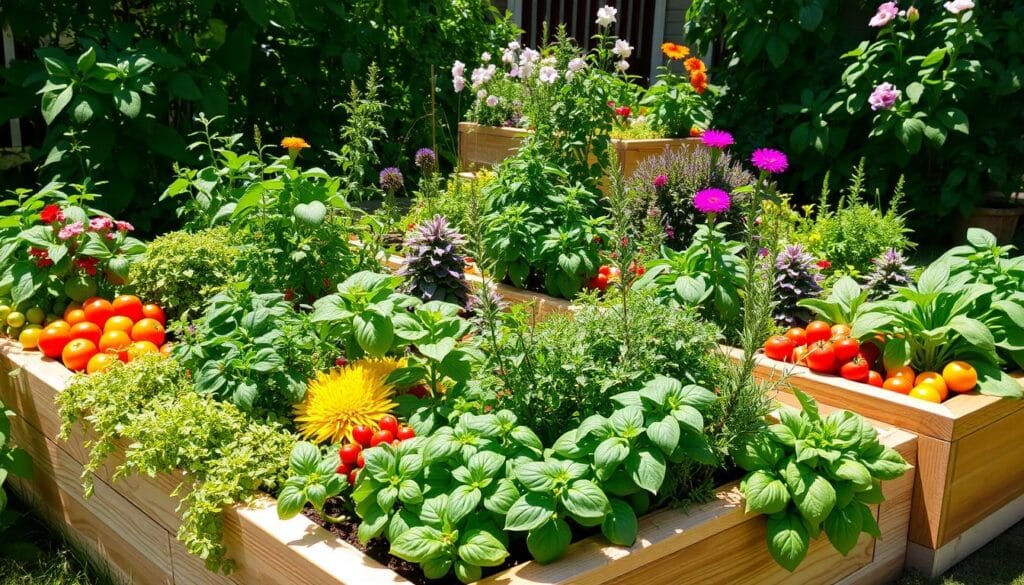Are you looking to change your outdoor space? There are many raised bed garden ideas to explore. You can design a unique feature that fits your style and needs. Raised bed gardening tips help pick the best plants for your garden. This way, you can choose the soil, which is great if your ground isn’t good for gardening.
Raised bed gardening has many benefits. It lets you use space better and create a beautiful garden. With the right tips, you can pick the best plants. This way, you’ll have a beautiful and functional garden.
Key Takeaways
- You can get creative with raised bed garden ideas to design a unique landscaping feature.
- Raised bed gardening tips can help you choose the best plants for raised beds.
- Raised bed gardening allows you to select the soil mixture you want, which is helpful in areas with substandard soil.
- Raised beds can help maximize garden space and create a unique landscaping feature.
- With the right raised bed gardening tips, you can create a thriving garden that brings you joy and satisfaction.
- Raised bed gardening offers numerous benefits, including easier maintenance and reduced soil compaction.
- You can use raised bed garden ideas to create a garden that is both functional and aesthetically pleasing.
Introduction to Raised Bed Gardening
Raised bed gardening is a simple way to grow your food. You can make your own DIY raised garden bed projects to beautify your backyard. This method offers better drainage and warmer soil, extending the growing season.
Adding vermiculite to the soil helps with drainage. The structure should also let out excess moisture.
For raised bed design inspiration, the options are vast. You can use wooden kits or get creative with cinder blocks or bricks. The goal is to design something that suits your garden needs.
Here are some benefits of raised bed gardening:
- Improved drainage and warmer soil
- Increased accessibility and ease of maintenance
- Reduced weed growth and soil compaction
- Extended growing season
To make a thriving raised bed garden, follow these tips. Mix topsoil and compost in your bed. Also, ensure it gets at least 8 hours of sunlight daily for best plant growth.
With some planning and creativity, you can have a beautiful raised bed garden. It will meet your needs and give you a rich harvest. Whether you’re new to gardening or experienced, raised bed design inspiration and DIY raised garden bed projects will guide you to success.
| Soil Mix | Recommended Percentage |
|---|---|
| Topsoil | 50-60% |
| Compost | 40-50% |
Choosing the Right Location for Your Raised Bed
The location of your raised bed is key for success in vegetable gardening. It should get enough sunlight, have good drainage, and have the right soil. Using raised garden bed layout ideas can help you use your space well, but remember these important factors.
Sunlight is crucial. Most plants need 6-8 hours of direct sunlight daily. If your spot gets partial shade, you can still grow plants like lettuce and herbs that need less sunlight. Use trellises or supports to get more sunlight for your plants.

Drainage and soil quality are also vital. Your raised bed should be in a spot with well-draining soil to avoid waterlogged soil and root rot. If your yard’s soil is poor, use raised beds with drainage systems or add organic matter to improve it. By picking the right spot and using good layout ideas, you can have a thriving garden.
Sunlight Considerations
Sunlight is key for a successful garden. Root crops and larger fruiting crops need at least 6 hours of full sunlight. Baby greens, lettuce, and herbs do well with 4 hours of sunlight. Two hours of partial shade is like one hour of full sun.
Drainage and Soil Quality
Soil quality is important for raised bed location. Drainage and soil type matters a lot. Paths to raised beds should be at least 3 feet wide for easy movement and work. Raised bed width depends on how you’ll harvest, with beds up to 3 feet wide for one-sided access and up to 4 feet for both sides.
Materials for Building Raised Garden Beds
Choosing the right material for your raised bed garden is key to its success. You have options like wood, metal, and composite materials. Wood is a favorite for its natural look and strength. But, it needs more care than other materials.
Popular wood choices include cedar, pine, and spruce. These woods fight off rot and bugs well, perfect for outdoors. Metal and composite materials, meanwhile, bring a modern vibe and can be eco-friendly. For example, corrugated metal can make a unique and useful raised bed.
Wood Options
Wood is a top pick for raised beds because of its natural beauty and lasting quality. Cedar, pine, and spruce are favorites. They resist rot and bugs, making them great for the outdoors.
Metal and Composite Materials
Metal and composite materials give a modern look and can be eco-friendly. Corrugated metal, for instance, can craft a special and handy raised bed. You can stack these metals for different plants and frame them with wood to keep the edges safe.
Recycled Materials
Recycled materials, like cinder blocks, are also good for raised beds. Cinder blocks have holes and are 16 inches long and 8 inches tall. They’re a smart choice for a unique and useful raised bed.

Think about the good and bad of each material for your raised bed garden. With the right planning and building, your garden will flourish and give you a rich harvest.
| Material | Pros | Cons |
|---|---|---|
| Wood | Natural appearance, durable | May require more maintenance |
| Metal | Durable, low-maintenance | May be more expensive |
| Composite | Durable, low maintenance | May be more expensive |
Dimensions and Design Ideas for Raised Beds
Creating a beautiful raised bed garden starts with the right dimensions and design. You can find many ideas online, from simple shapes to unique ones. Think about the space you have and the plants you want to grow.
A common size is 4′ x 8′, but you can also use stock tanks or other containers. Choose a size and design that fits your space and needs. DIY projects often use reclaimed wood or metal for a unique look.
Standard Sizes for Raised Beds
Raised beds come in sizes from 4′ x 4′ to 4′ x 12′. Pick a size based on the plants you want to grow and how much space they need.
Unique Shapes and Configurations
For something different, try using a stock tank or other container. You can mix materials like wood and metal for a unique bed. Some cool shapes include:
- Round or circular raised beds
- Square or rectangular beds with a trellis or arbor
- Keyhole beds with a self-composting cage
- Hugelkultur beds using rotting logs and plant debris

Think about your plants’ needs when designing your bed. Consider sunlight and water needs. With creativity and planning, you can make a beautiful and useful raised bed garden.
| Raised Bed Size | Materials Needed | Space Required |
|---|---|---|
| 4′ x 4′ | 2″ x 6″ lumber, 2″ x 4″ lumber, screws | 16 square feet |
| 4′ x 8′ | 2″ x 6″ lumber, 2″ x 4″ lumber, screws | 32 square feet |
| 4′ x 12′ | 2″ x 6″ lumber, 2″ x 4″ lumber, screws | 48 square feet |
Companion Planting Strategies for Raised Beds
Choosing the right plants for raised beds is key to a great harvest. Companion planting is a method where different plants are grown together. This helps them grow better, keeps pests away, and boosts yields. It’s especially helpful in raised beds where space is tight.
Companion planting makes raised bed gardens diverse and thriving. For instance, marigolds with tomatoes can fight nematodes. Basil and tomatoes together improve growth and taste. Beans with corn and squash, and nasturtiums as a trap crop for aphids, are other good pairs.
Some top plants for raised beds attract pollinators or repel pests. Calendula and zinnia attract bees, while garlic and chives keep pests away. Here are some effective companion planting combinations for raised beds:
- Tomatoes and basil: Improve growth and flavor
- Marigolds and tomatoes: Repel nematodes
- Beans, corn, and squash: Create a diverse and thriving ecosystem
- Nasturtiums and aphid-susceptible plants: Attract aphids away from other plants

Using companion planting in your raised bed garden makes it healthier and more productive. It means you need fewer chemicals and get more from your garden.
| Plant Combination | Benefits |
|---|---|
| Tomatoes and Basil | Improve growth and flavor |
| Marigolds and Tomatoes | Repel nematodes |
| Beans, Corn, and Squash | Create a diverse and thriving ecosystem |
Seasonal Planting Ideas for Raised Beds
When planning your raised bed garden, think about the seasons and how they affect your garden. With the right tips, you can have a garden that’s always growing. In spring, plant cool-season crops like lettuce, spinach, and peas.
In summer and fall, switch to warm-season crops like tomatoes, peppers, and eggplants. Also, add herbs, succulents, and flowers for color and texture. For example, calibrachoa and sweet alyssum are perfect for spilling over, as seen in CaliKim’s garden.
Spring Planting Suggestions
- Leafy greens like kale and spinach
- Root vegetables like carrots and beets
- Herbs like cilantro and dill
Summer and Fall Crop Options
- Tomatoes and peppers
- Cucumbers and squash
- Flowers like marigolds and sunflowers
By using these tips and seasonal planting ideas, you’ll create a lively and productive garden. It will thrive all year long.
| Season | Crop Options |
|---|---|
| Spring | Leafy greens, root vegetables, herbs |
| Summer and Fall | Tomatoes, peppers, cucumbers, squash, flowers |
Incorporating Vertical Gardening Techniques
When you start on DIY-raised garden bed projects, think about using vertical gardening. It lets you grow more plants in a small space. This is great for city gardens or tight spots. You can make a garden that’s both useful and shows off your style.
Vertical gardening helps plants breathe better, cutting down on powdery mildew. It makes picking fruits and veggies easier, without the need to bend or crawl. Plus, it keeps your produce clean, which helps avoid attracting bugs.
Benefits of Vertical Gardening
Vertical gardening has many advantages:
- More space for plants
- Better air for plants
- Picking is simpler
- Less soil loss
- It looks good too
Ideal Plants for Vertical Growth
For vertical gardens, pick plants that climb or spread. Some top choices are:
- Pole beans
- Vining beans
- Peas
- Cucumbers
- Squashes
Adding vertical gardening to your DIY projects makes your garden special. It lets you use your space well and grow many plants. You can even grow plants that do well when they’re up high.
| Plant | Vertical Growth Habit | Support Required |
|---|---|---|
| Pole beans | Climbing | Trellis or cage |
| Cucumbers | Climbing | Trellis or fence |
| Squashes | Spreading | None or minimal |
Creative Raised Bed Garden Layouts
Building a raised bed garden opens up endless possibilities. With a bit of creativity, you can make a garden that’s both beautiful and useful. Planning your raised bed garden is crucial for a stunning and productive space.
One great way to design your garden is through square-foot gardening. This method divides your bed into small squares, each about one square foot. You can plant different crops in each square. This way, you make the most of your space and reduce waste.
For example, you can mix vegetables, herbs, and flowers in each square. This creates a diverse and lively garden.
Another idea is to build a tiered or multi-level garden. You can stack multiple beds or use one with different levels. This adds depth and interest to your garden. Natural stone or other materials can help create borders and add texture.
- Choose a location that receives at least six hours of sunlight per day
- Select a mix of plants that thrive in your local climate and soil type
- Use a combination of plants with different growth habits and textures to add visual interest
- Consider using a trellis or other support system for climbing plants
| Plant Type | Space Requirements | Sunlight Needs |
|---|---|---|
| Vegetables | 1-3 square feet | Full sun |
| Herbs | 1-2 square feet | Partial shade |
| Flowers | 2-4 square feet | Full sun |
By using these tips and thinking about what you need, you can create a beautiful raised bed garden. It will add joy and freshness to your outdoor space.
Maintenance Tips for Raised Bed Gardens
When you care for your raised bed garden, remember some key raised bed gardening tips. One big challenge is keeping the soil moist, as raised beds dry out quicker. To solve this, think about using a self-watering system or drip irrigation.
Choosing the right plants for raised beds is crucial. Pick varieties that match your soil and conditions. Leafy greens and herbs need at least 6 inches of soil. Tomatoes and squash require 12-18 inches. Planting densely helps keep the soil moist and weeds away.
To keep the soil healthy, add a Vegetable Amendment Mix or organic compost every six months. This keeps the soil rich and fertile. Also, use Bio-Live organic fertilizers to boost root growth and feed microbes.
| Soil Type | Recommended Depth | Plant Examples |
|---|---|---|
| Topsoil | 6-8 inches | Leafy greens, herbs |
| Nutrient-rich soil | 12-18 inches | Tomatoes, squash, carrots |
By using these raised bed gardening tips and picking the right plants for raised beds, you can have a vibrant and fruitful garden. It will give you joy and fresh produce all season.
Conclusion: Transforming Your Outdoor Space with Raised Beds
There are many raised bed garden ideas to explore. You can create a unique landscaping feature. Raised beds let you pick the soil, which is great if your ground’s soil isn’t good for gardening.
By using drought-resistant plants, mulching, and smart irrigation, you can make a beautiful, easy garden. This garden will be a peaceful oasis.
Container gardens, rock and gravel beds, and no-dig raised beds offer endless options. Try different heights, textures, and colors to change your outdoor area. With creativity and planning, you can have a garden that’s both thriving and easy to care for. It will show off your style and love for nature.
Frequently Asked Questions
What is a raised bed garden?
A raised bed garden is a way to garden where the soil is in a raised area. This area is often made of wood, metal, or other materials. It lets you choose the soil and adds a special touch to your yard.
What are the benefits of raised bed gardening?
Raised bed gardening has many perks. You can pick the soil, improve drainage, and use space better. It also lets you get creative and fit gardens into small spaces.
What are the best plants for raised beds?
Plants that do well in raised beds are those that like well-drained soil and don’t have deep roots. Good choices include leafy greens, herbs, tomatoes, peppers, and many vegetables and flowers.
How do I build a raised garden bed?
You can make a raised bed yourself using wood, metal, or recycled stuff. Think about how long it will last, how much it costs, and how it looks. Many stores sell pre-made kits that are easy to put together.
How do I choose the right location for my raised bed?
Pick a spot for your raised bed that gets lots of sunlight and drains well. It should get at least 6 hours of direct sun a day. Stay away from places where lots of people walk and areas that hold water.
What are some creative design ideas for raised beds?
Raised beds can be any shape, from simple rectangles to fancy designs. You can even add vertical gardening with trellises or hanging baskets. This makes the most of your space.
How do I maintain my raised bed garden?
Keeping your raised bed garden up means watering, weeding, and controlling pests. Add compost or organic matter to the soil every year to help your plants. Using self-watering systems or trellises can make caring for your garden easier.
Source Links
- Make Gardening Easier with These Beautiful Raised Garden Bed Ideas
- 13 Easy DIY Raised Garden Bed Ideas
- 27 Raised Garden Bed Ideas to Transform Your Outdoor Space
- Guide to Raised Beds: Plans, Timing, Tending | Gardener’s Supply
- A Beginner’s Guide to Raised Bed Gardening
- 5 Best Raised Bed Garden Layouts for Maximizing Your Growing Space
- Before You Start Planting In Your Raised Garden Bed, Check Out These 3 Layouts
- The Ultimate Guide to Picking a Location for Your Raised Bed Vegetable Garden
- How to Build Raised Garden Beds
- 32 Raised Garden Bed Design Ideas
- Raised Garden Bed Materials: What’s Good?
- Raised Bed Garden Plan – Must Love Lists
- 16 Unique Raised Garden Bed Ideas For Every Landscaping Need
- How to Build Raised Garden Beds | Thunderbird Disco Homestead – Permaculture Homesteading Blog
- Garden Companion Planting Chart, Plans, and Benefits
- Companion Planting Chart and Guide for Vegetable Gardens
- Companion Planting Chart For Raised Garden Beds | VEGEGA
- 25 Raised Garden Bed Ideas for Growing Your Favorite Veggies and Flowers
- Guide to Raised Beds: Plans, Timing, Tending | Gardener’s Supply
- Easy Planting Plans for Raised Garden Beds & Planters
- Raised Garden Beds Ideas to Elevate Your Garden – Cutters Edge
- 12 Vertical Gardening Ideas to Turn Your Small Space Into an Outdoor Paradise
- Vertical Vegetable Garden – High Yields In Less Space
- 13 Raised Garden Bed Ideas for Easy, Flexible Growing
- 13 Raised Bed Garden Design Ideas
- Expert-Approved Garden Bed Ideas to Up Your Growing Game
- How to Maintain and Replenish Your Raised Garden Beds – Lyngso Garden Materials
- Guide to Raised Beds: Plans, Timing, Tending | Gardener’s Supply
- Gardening tips for raised beds
- Effortless Elegance: Low Maintenance Garden Bed Ideas to Revamp Your Outdoors – Bluestem Gardening
- Transform a Garden Space Part 1: Height
- Permaculture Basics: Designing a Self-Sustaining Garden










